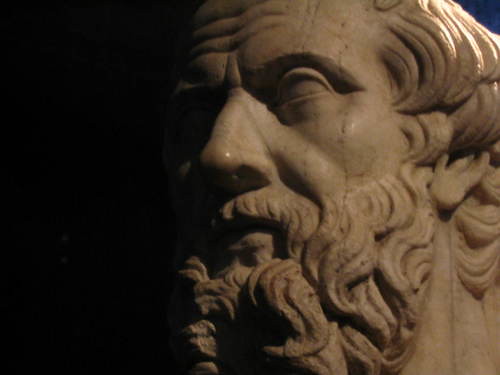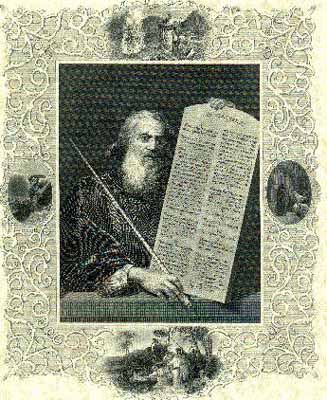
Greek Drama can be found to date back to the religious worship of Dionysus as far back as 1200BC. One of the central rites of Dionysus was the dithyramb. Dithyramb means "Choric hymn," a hymn accompanied by mimic gestures and most likely music. This dancing and singing rose to the form of artistic poetry by 600BC, becoming a competition in various Athenian festivals. It soon ceased to be centered around Dionysus and began to include other heroes of Greek Mythology. In 543 BC, the ruler of Athens, Pisistratus, changed the Dionysian Festivals and began drama competitions. The competitions became popular annual events.
Two types of dramas evolved. The first being the Tragedy and the Satyr play. The tragedies had a noble purpose to teach religious lessons, much like the parables of our Bible. They were designed to show the consequences of taking the wrong path in life. The protagonists of the dramas pitted themselves against fate, society or life's rules. Most often the main character's major fault is "hubris" or unmerited arrogance.
The second type of drama is the comedy. Originally comedies were considered trivial and common. The most famous Greek comedy writers were Aristophanes and Cratinus. They too were presented at the Athenian festivals.
Only a small number of tragedies survived as full texts from the annual competitions in Athens, but they include work by three dramatists of genius. The earliest is the heavyweight of the trio, Aeschylus.
Aeschylus added a second actor, increasing the potential for drama. He first won the prize for tragedy in 484 BC. He is known to have written about eighty plays, of which only seven survive. One of his innovations was to write the day's three tragedies on a single theme, as a trilogy. By good fortune three of his seven plays are one such trilogy, which remain one of the theatre's great masterpieces - the Oresteia, celebrating the achievement of Athens in replacing the chaos of earlier times with the rule of law.
Sophocles gained his first victory in 468 BC, defeating Aeschylus. He is credited with adding a third actor, further extending the dramatic possibilities of a scene. Whereas Aeschylus tended to deal with great public themes, the tragic dilemmas in Sophocles are worked out at a more personal level. Plots became more complex, characterization more subtle, and the personal interaction between characters more central to the drama.
Although Sophocles in a very long life wrote more plays than Aeschylus (perhaps about 120), again only seven survived intact. Of these Oedipus the King is generally considered to be his masterpiece.
The youngest of the three great Greek tragedians was Euripides. More of his plays survived (19 as opposed to 7 for each of the others), but he had fewer victories than his rivals in the City Dionysia - in which he first competed in 454 BC.
Euripides introduced a more unconventional view of Greek myth, seeing it from new angles or viewing mythological characters in terms of their human frailties.
The Greek Theater
Greek tragedies and comedies were always performed in outdoor theaters. Early Greek theaters were probably little more than open areas in city centers or next to hillsides where the audience, standing or sitting, could watch and listen to the chorus singing about the exploits of a god or hero. From the late 6th century BC to the 4th and 3rd centuries BC there was a gradual evolution towards more elaborate theater structures, but the basic layout of the Greek theater remained the same. The major components of Greek theater are labled on the diagram above.
Orchestra: The orchestra (literally, "dancing space") was normally circular. It was a level space where the chorus would dance, sing, and interact with the actors who were on the stage near the skene. The earliest orchestras were simply made of hard earth, but in the Classical period some orchestras began to be paved with marble and other materials. In the center of the orchestra there was often a thymele, or altar. The orchestra of the theater of Dionysus in Athens was about 60 feet in diameter.
Theatron: The theatron (literally, "viewing-place") is where the spectators sat. The theatron was usually part of hillside overlooking the orchestra, and often wrapped around a large portion of the orchestra (see the diagram above). Spectators in the fifth century BC probably sat on cushions or boards, but by the fourth century the theatron of many Greek theaters had marble seats.
Skene: The skene (literally, "tent") was the building directly behind the stage. During the 5th century, the stage of the theater of Dionysus in Athens was probably raised only two or three steps above the level of the orchestra, and was perhaps 25 feet wide and 10 feet deep. The skene was directly in back of the stage, and was usually decorated as a palace, temple, or other building, depending on the needs of the play. It had at least one set of doors, and actors could make entrances and exits through them. There was also access to the roof of the skene from behind, so that actors playing gods and other characters (such as the Watchman at the beginning of Aeschylus' Agamemnon) could appear on the roof, if needed.
Parodos: The parodoi (literally, "passageways") are the paths by which the chorus and some actors (such as those representing messengers or people returning from abroad) made their entrances and exits. The audience also used them to enter and exit the theater before and after the performance.
Hopefully this will give us some much needed background information before we read Oresteia.











